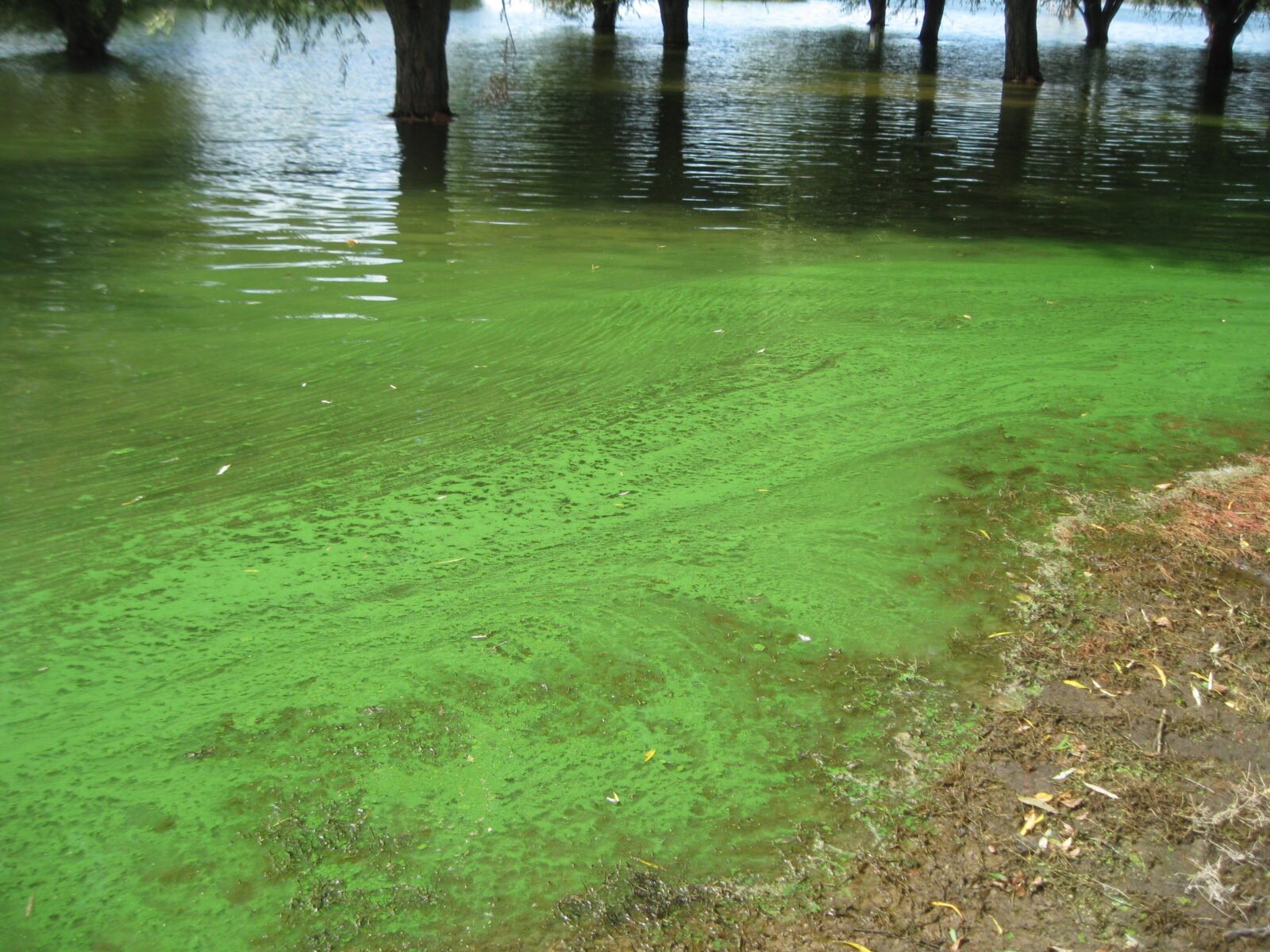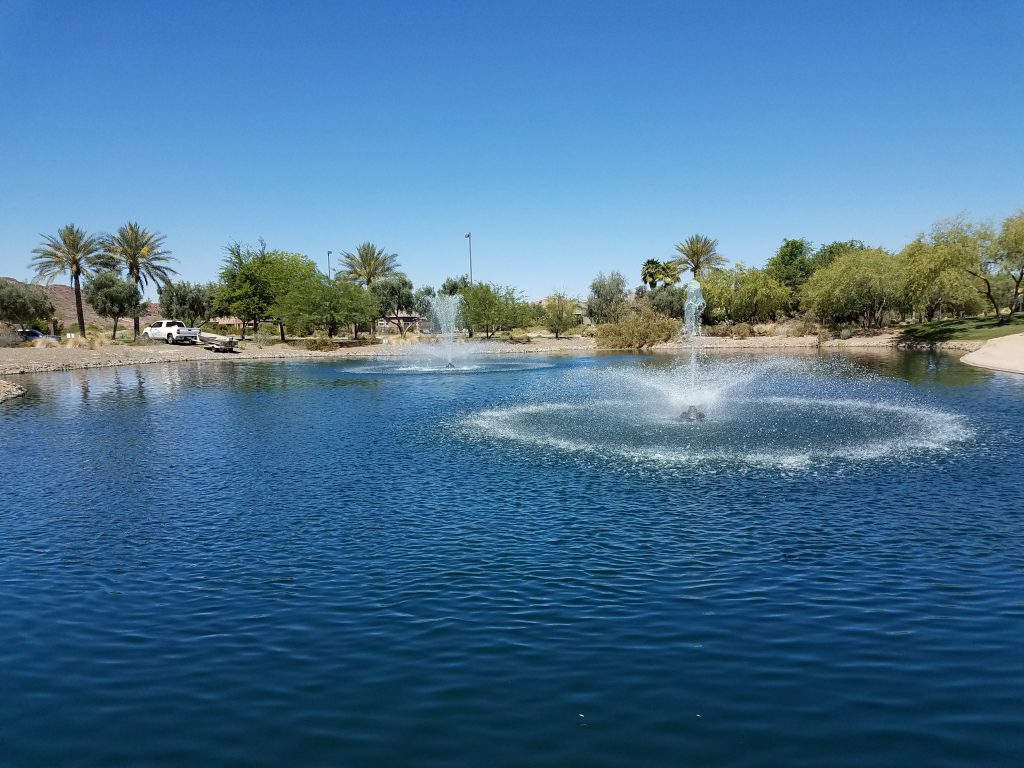
Spring is upon us and with warm weather comes the threat of dreaded algae blooms. The best way to manage nuisance pond algae and aquatic weeds is to be proactive and focus on restoring ecological balance to your lake, pond or stormwater basin. Year-round maintenance and prevention techniques will significantly help to reduce the prevalence of algae blooms. Here are some environmentally friendly algae control methods used to promote attractive and bluer lakes and ponds in your community: First, it is important to improve your overall site by repairing areas of erosion that increases the flow of sediment into your lake or pond. The shallower the water, the warmer the water temperature gets, and the easier it is for algae to grow. Sediment is also typically loaded with nutrients like phosphorus and nitrogen. An overabundance of nutrients in the water can cause unwanted algae growth. Avoid grass clippings, leaves, fertilizer and other nutrient loaded organic debris from getting into your waterbody. During the growing season, limit mowing around your lake or pond to help establish a protective vegetative buffer. You can also create a buffer by planting beneficial vegetation around the edges of your lake or pond. This will stabilize the bank and help act as a filter to reduce the amount of nutrient build-up in the water.

Benefits of An Aeration System
One of the best practices for helping to maintain your water and prevent the accumulation of nutrients that could lead to excessive algae is to install and continuously run a submersed air diffused or floating surface aeration system. Aerators increase diffused oxygen in the water, which in turn supports and encourages the growth of beneficial aerobic bacteria. This beneficial bacteria breakdown organic matter and consume excess nutrients which helps to balance and improve water quality and reduce algae blooms. Biological augmentation can also significantly improve water quality by utilizing naturally occurring microbes and enzymes that aid in the maintenance of healthy water ecosystems. The dosing of these naturally-occurring micro-organisms boosts the natural populations in your ponds, helping to further reduce the accumulation of nutrients and organic sludge, thus removing the primary food source for the algae.
Effects of Excess Phosphorous on a Body of Water
All ponds go through a natural aging process called eutrophication. This process is accelerated in many developed watersheds due to the loading and accumulation of excess phosphorous in the pond water and sediments. When excess phosphorus begins to have undesirable impacts to the balance and health of aquatic ecosystems, the negative impacts to water quality may be considered a form of pollution. Even when external sources of phosphorus have been curtailed by watershed management practices (i.e. reduced lawn fertilizers, shoreline buffers, stormwater management, improved agriculture practices), the years of accumulation and internal recycling of phosphorus in ponds can continue to degrade water quality and clarity for years to come.
A relatively new product, Phoslock, can permanently inactivate phosphorus from the water column and lock available forms of phosphorus in the bottom muck of the pond. By addressing phosphorus pollution, you will can proactively put your pond on a path to water quality restoration. All of these strategies are centered around using techniques and products that are natural and completely safe for use in the aquatic environment, with no adverse effects on fish, macro invertebrates, or other wildlife. There are several other less natural, but equally safe “tools in the toolbox” that can be used if algae blooms continue to pose a problem in your lake or pond. An ultra-sonic algae control device can be placed in the water and is used to rid it of certain types of algae without harming other aquatic life. Lake and pond dye can be added to a waterbody to help filter out UV sunlight, thereby slowing algae growth. Your lake or pond will also benefit aesthetically from a beautiful, natural shade of blue!
Restoring Ecological Balance to Your Body of Water
If all of your efforts to improve water quality and prevent algae are not enough, algaecides can be applied safely and effectively to control existing algae blooms before they get worse. However, after treatment, it is still imperative that you implement a program designed around balance and preventing algae through water quality improvements. Otherwise, you will find your lake or pond with recurring algae blooms, needing continuous treatments with algaecides. This becomes a cycle that is never-ending, and must be broken! Overall, be sure that your lake or pond is set up on a customized, annual management plan, so that naturally occurring and environmental safe practices are incorporated throughout the year to minimize algae growth, especially in the warmer months. Spring is here and a hot summer is upon us, are your lakes or ponds ready?!
Contact Us to Build Your Lake Management Plan
Call us at 888-480-5253 or complete the form below to connect with an aquatic management expert.
SOLitude Lake Management is a nationwide environmental firm committed to providing sustainable solutions that improve water quality, enhance beauty and preserve natural resources.
SOLitude’s team of aquatic scientists specializes in the development and execution of customized lake, stormwater pond, wetland and fisheries management programs. Services include water quality testing and restoration, algae and aquatic weed control, installation and maintenance of fountains and aeration systems, shoreline erosion control, muck and sediment removal and invasive species management. SOLitude partners with homeowners associations, golf courses, private landowners, businesses and municipalities. SOLitude Lake Management is part of Rentokil, a leading business services company, operating across the United States, Canada and Puerto Rico.
For more information, visit SOLitude Lake Management at solitudelakemanagement.com, and connect on Facebook, LinkedIn and Twitter.









